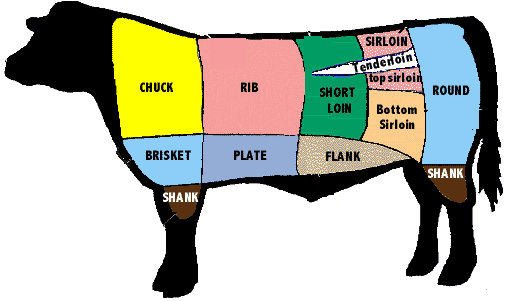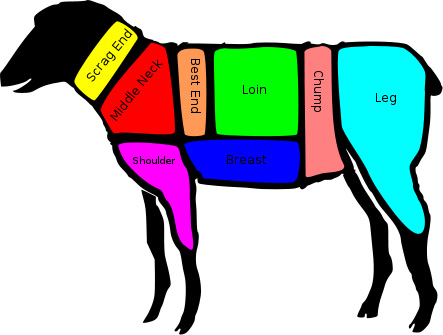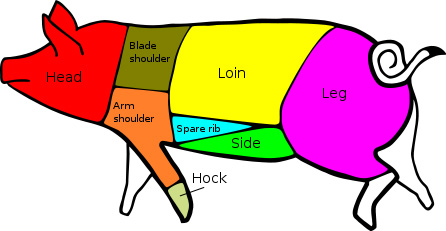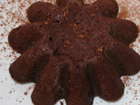Know your cuts of meat for Beef, Pork and Lamb
Cuts of beef
(This section denotes the American system of beef cutting. Other cultures have similar systems, but the exact cuts and terminology differ).

Common cuts of beef. -- Know your cuts of Beef
Primal cuts
Beef is first divided into primal cuts. These are basic sections from which steaks and other subdivisions are cut. The following is a list of the primal cuts, ordered front to back, then top to bottom. The short loin and the sirloin are sometimes considered as one section. --
CHUCK
- Chuck - one of the most common sources for hamburger. Chuck is a heavily exercised area. However, this area contains a great deal of connective tissue, including collagen. Collagen melts during cooking, making the meat intensely flavorful. Cuts from this area will benefit from slow, wet cooking methods like stewing, braising or pot-roasting. ---Pot Roast, Short Ribs, Top Blade Steak
RIB SECTION
- Rib Eye Roasts
- Rib Eye Steaks
SHORT LOIN SECTION
Short Loin - the most tender, and the most expensive --can be prepared without the aid of moist heat or long cooking times. Cuts from the short loin may be sautéed, pan fried, broiled, pan broiled or grilled.-
- Porterhouse Steak --very popular steak cut from the rear end of the short loin; the name originated from the days when it was served in public Ale Houses that also served a dark beer called porter. The porterhouse consists of both tenderloin and strip steak. The tenderloin is often served separately as filet mignon
- T-bone Steak —cut from the middle section of the short loin; similar to the porterhouse steak; has a smaller piece of the tenderloin; usually grilled or pan-fried.
- Tenderloin -- this is often considered the most tender cut of beef. It can be cut as the whole strip of meat, or into individual filet steaks (filet mignon). The meat responds well to sauces, meaning the meat does not overpower the flavor of the sauce.
SIRLOIN
Sirloin is less tender than short loin, but more flavorful. Sirloin is found in the area of the hipbone. These tender cuts respond well to sautéing, pan-frying, broiling, pan-broiling or grilling. e.g., sirloin steaks which are available in a variety of boneless and bone-in steaks and sirloin tip roast which are excellent when dry roasted or marinated
ROUND
The round is part of the hip muscle and consists of lean meat well suited to long, moist cooking methods. Top Round is the most tender part of the round and can be prepared as pot roast or cut into thick steaks for braised dishes. Rump Roast is considered a very popular cut for pot roast, but can also be roasted at low temperatures.
LOWER HALF
- FORESHANK -- Shank Cross Cuts and Beef Stew
- BRISKET -- Corned Beef and Brisket --Brisket First Cut —a leaner cut of the brisket, for those who want the flavor but not the fat of a brisket pot roast -- Brisket Front Cut—fork tender and succulent,
- SHORT PLATE - Short Ribs, Beef for Stew, Ground Beef
- FLANK -- Flank Steak, Skirt Steak, Steak Rolls
- TIP- Tip Steak, Tip Roast, Tip Kebobs
Cuts of Lamb

Australia, UK and Canada Cuts of Lamb
Approximate zones of the usual UK cuts of lamb:
- Scrag end (of neck)
- Middle neck
- Best end (of neck)
- Loin
- Chump (and chump chops)
- Leg
- Shank
- Shoulder
- Breast
USA Cuts of Lamb
- Square cut shoulder -- shoulder roast, shoulder chops and arm chops
- Rack --rib chops and riblets, rib roast
- Loin -- loin chops or roast
- Leg-- sirloin chops, leg roast (leg of lamb)
- Neck
- Breast
- Shanks (fore or hind)
- Flank
Cuts of Pork
American Cuts of Pork

British Cuts of Pork
- Head - This can be used to make brawn, stocks and soups. After boiling, the ears can be fried or baked and eaten separately.
- Spare Rib Roast/Spare Rib Joint/Blade Shoulder/Shoulder Butt - This is the shoulder and contains the shoulder blade. It can be boned out and rolled up as a roasting joint, or cured as "collar bacon". Not to be confused with the rack of spare ribs from the front belly. Pork butt, despite its name, is from the upper part of the shoulder. Boston Butt, or Boston-Style Shoulder, cut comes from this area, and may contain the shoulder blade.
- Hand/Arm Shoulder/Arm Picnic - This can be cured on the bone to make a ham-like product, or used in sausages
- Loin - This can be cured to give back bacon or Canadian-style bacon. The loin and belly can be cured together to give a side of bacon. The loin can also be divided up into roasts (blade loin roasts, center loin roasts, and sirloin roasts come from the front, center, or rear of the loin), back ribs (also called baby back ribs, or riblets), pork cutlets, and pork chops. A pork loin crown roast is arranged into a circle, either boneless or with rib bones protruding upward as points in a crown. Pork tenderloin, removed from the loin, should be practically free of fat.
- Fatback - The subcutaneous fat and skin on the back are used to make pork rinds, a variety of cured "meats", lardons, and lard.
- Belly/Side/Side Pork - The belly, although a fattier meat, can be used for steaks or diced stir-fry meat. Belly pork may be rolled for roasting or cut for streaky bacon.
- Legs/Hams - Although any cut of pork can be cured, technically speaking only the back leg is entitled to be called a ham. Legs and shoulders, when used fresh, are usually cut bone-in for roasting, or leg steaks can be cut from the bone. Three common cuts of the leg include the rump (upper portion), center, and shank (lower portion).
- Trotters - Both the front and hind trotters can be cooked and eaten, as can the tail.
- Spare ribs, or spareribs, are taken from the pig's ribs and the meat surrounding the bones. St. Louis-style spareribs have the sternum, cartilage, and skirt meat removed.
- Knuckles, intestines, jowls and all other parts of the pig may also be eaten.
